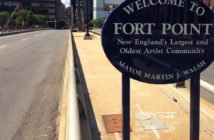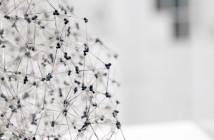While driving home from my family's house on Black Friday I was surprised to see an open sign in front of the Boston Cyberarts Gallery. I had missed the opening event for their new show and had been meaning to stop by but hadn't yet found time when our schedules overlapped. Still coming down my calorie-high the day before, I wasn't sure that I felt completely prepared to spend time with the work and engage with it in the way that I needed. Strangely, I found that I was unprepared, though for a different reason.
Before I explain let me first say that this gallery space, though not drastically transformed from its previous iteration as Axiom (which by the time it ended its run was already a subsidiary of Boston Cyberarts), feels different. It may be the new wall behind the desk or the re-branding or the fact that when I visited the gallery, I was greeted by George Fifield, who was staffing the space. It also may have been that during my visit there were eight other people in the small gallery, which may be the most amount I’ve ever seen in there at one time while an event wasn’t occurring. It felt exciting both to see this space be dedicated once again to showcasing emerging and established new media artists but also to witness other people being excited about it.
The current exhibition in the space, COLLISION18:Present, curated by COLLISIONcollective members William Tremblay, John Slepian and Bob Kephart, is a juried group show featuring artists whose work examines the "eternal present" through various means. Though many pieces felt as though they could exist in the eternal present of just about any group show a few did stand out both for their execution and relation to the theme.
Chronolgy: Present by Alexander Reben isn’t the first piece of art I’ve seen that has attempted to quantify the gaze of the viewer, though its simple formal presence allows you to better focus on your relationship to the work. Consisting of a small blank canvas fitted in the center with what looks like an odograph, as you move closer to the piece you notice the word "Hours" painted on it. While viewing the canvas, the Hours meter is slowly counting your presence with the aid of a hidden dopplar radar unit.
My favorite artist included by far was Sarah Buckius. Her videos, Everyday Absurdities and Impossible Kinetic Sculptures for the Home, are jerky, robotic, and enthralling. Through digital manipulation and looping of simple body movements and montages, Buckius is able to create uncomfortably exaggerated and distorted "sculptures". The frenetic patterns that are performed (especially in her Everyday Absurdities video, with conjoined, awkward forms) explore the general anxieties that often arise in interpersonal relationships, with persisting, inescapable "present" moments perfectly mirroring the nightmarish unease of feeling out of step.
Impossible Kinetic Sculptures for the Home from sarah buckius on Vimeo.
This all brings me back to my original problem: feeling completely unprepared to view a piece of art. First, I want to point out that coming across the Dataspacetime duo’s (Lisa Gwilliam and Ray Sweeten) Stuxnet is actually quite pleasurable. Here, they’ve generated a pixellized mosaic of an explosion made up of hundreds of colored QR codes. Pixellization and accumulation though arguably "easy" always create a powerful effect and that’s no different in their piece. It’s prominently displayed near the door so that you can have that great experience of slowly walking up to it to discover how it’s made—all well thought out. Where I find it problematic is in the work's and, more specifically, the QR code’s accessibility. To fully experience Stuxnet, the viewer is provided with a QR code next to the piece to download a customized DST Decoder onto your smartphone or iPad. Once downloaded, you’re able to scan the QR codes that make up the pixellized image and are redirected to Youtube videos that were gathered from an archive of searches of "Stuxnet" and "Cyber Warfare" on June 24, 2012— when the computer virus was thought to be programed to "expire". Additionally, their server stores the scanning histories of each QR code, allowing both the artists and the viewer to track how people are interacting with the piece. The concept and execution all go a far way towards forcing a viewer to understand the way that they interact with technology, data and internet.
At least that appears to be the intention. Frustratingly, I wasn't able to join in on this revelation. Now, here’s one glaring omission that could shed light on my frustrations: I don’t own a smartphone. I have nothing against them nor their prevalence nor their usefulness. I see all of my friends and colleagues using them and loving them and accessorizing them. There is nothing about them nor their usage that bothers me. I just happen to not own one and I’ve been reassured that that doesn’t make me a bad person. Beyond that, I realize how they, like any other piece of technology, can be used to create excellent artworks.
The question of the responsibility of accessibility isn't new to BR&S. Recently our Blog Editor, Anulfo Baez, brought up some similar points about access in a previous post, though contextually different. His argument, and also mine, is that it's difficult, if not impossible to engage your audience in a piece of art if they're not able to see it. Granted, none of the technology used in this piece would be considered "new" or unattainable—QR codes have been around since the mid-90s and we're already on the iPhone 5. But to knowingly mediate your work doesn't come without problems. Luckily after my visit I was able to delve further into the piece with research and understand the experience that I was missing. But, while none of that was available to me at the time of viewing, knowing that I was actively missing out on some part of this piece repeatedly brought up a question: How problematic or not is it to limit your viewership based on their access to technology? Ironically, the lack of access to this part of the piece brought me to the same supposed conclusion of being more acutely aware of how I interact (or don't) with data, technology, and the internet, but it's hard to believe that this roundabout way of getting there was deliberate. Though this doesn’t appear to be an intentional issue that was raised by the work, unfortunately it was one of the few pieces of communicable information that created a lasting impression.
- Everyday Absurdities Sarah Buckius Still from 37 Second video
- Stuxnet DataSpaceTime (Lisa Gwilliam and Ray Sweeten) Ink on Sintra 69 x 51″
- Chronology: Present (detail) Alexander Reben Canvas, electronics
COLLISION18:Present is open now through December 16. Gallery Hours: Friday, Saturday & Sunday 11am to 6pm. The gallery is on the ground floor level of the Green Street train stop on the Orange line. For more information visit their website.







